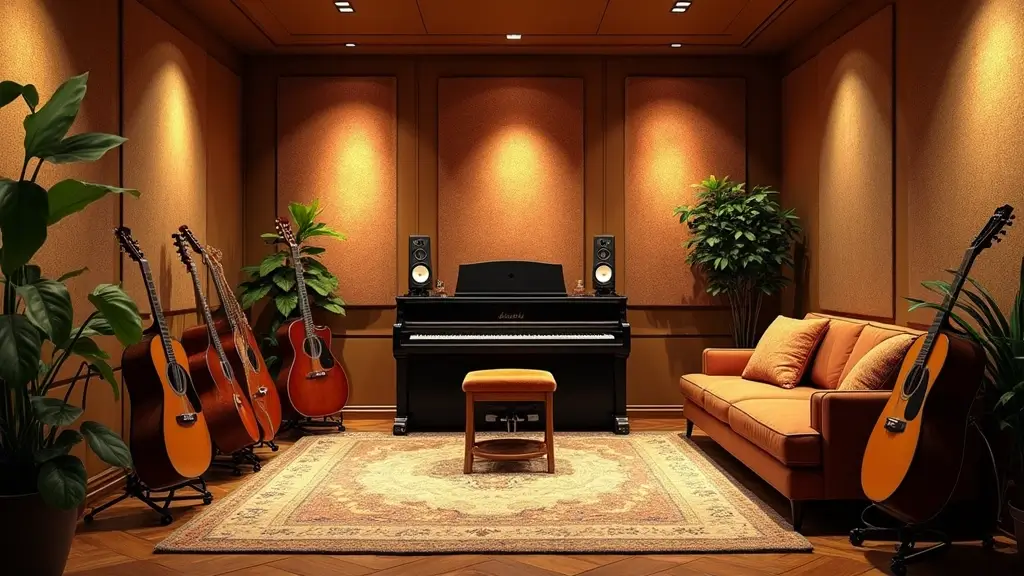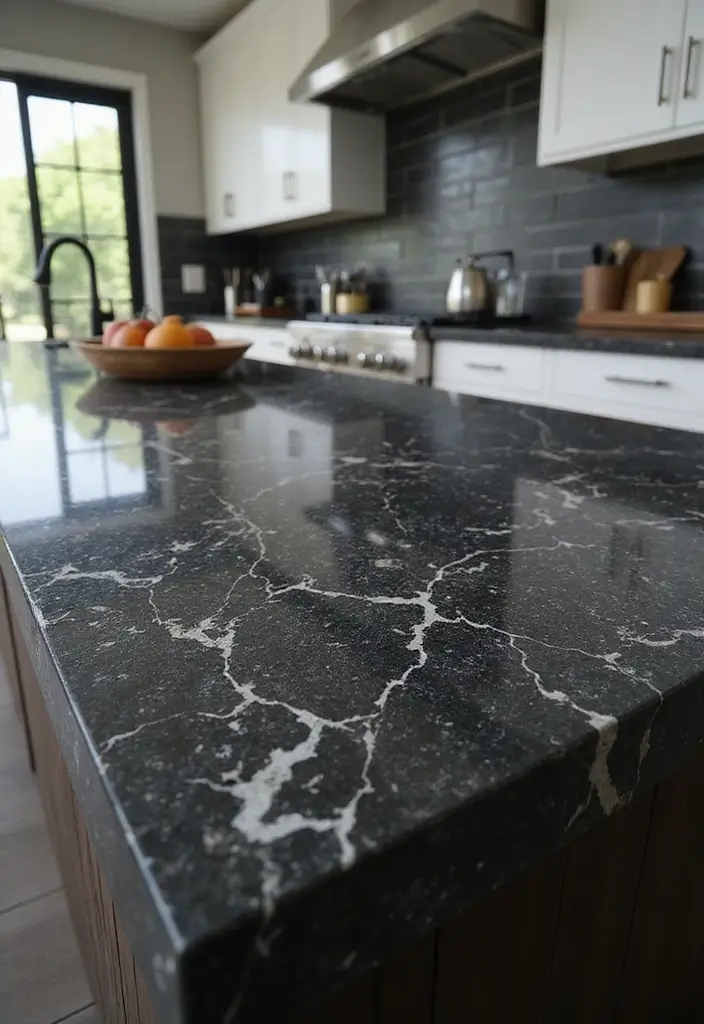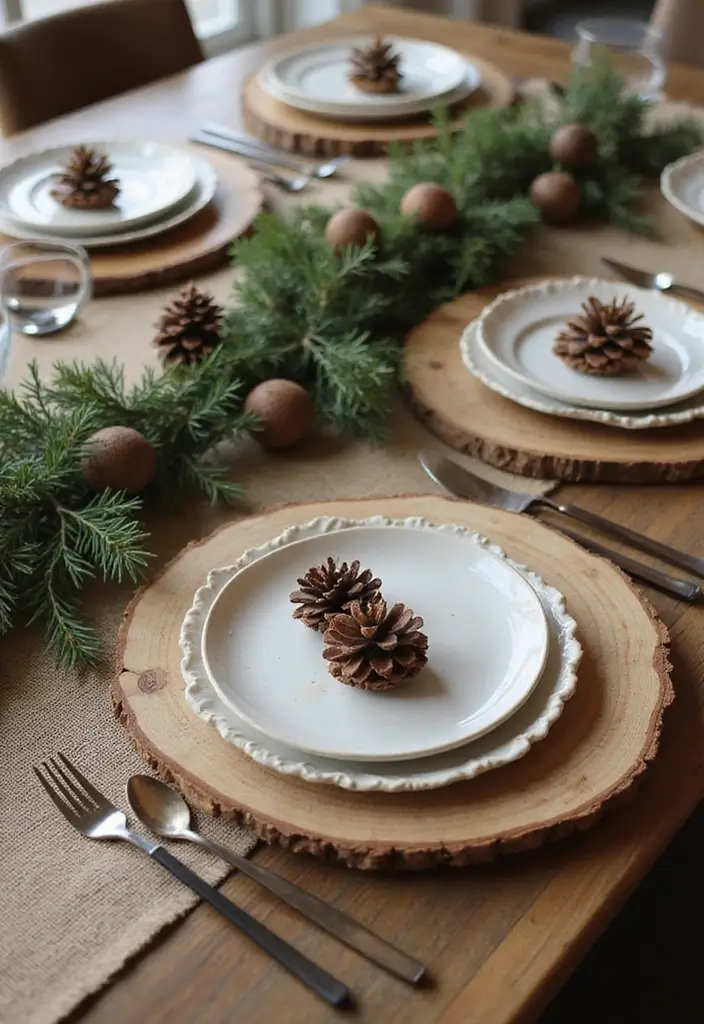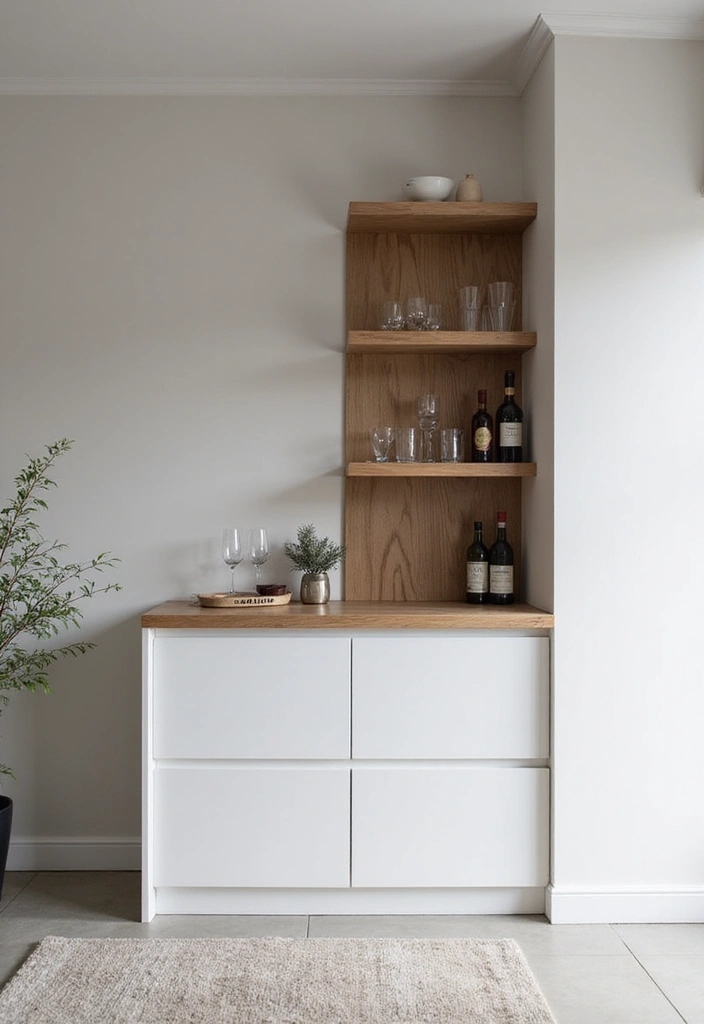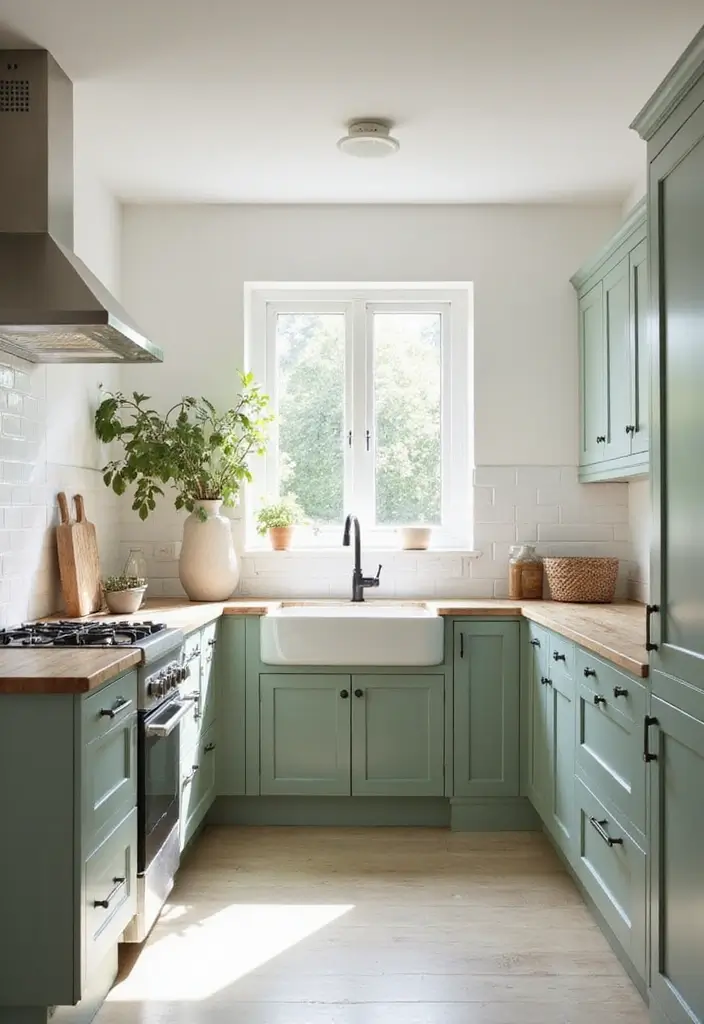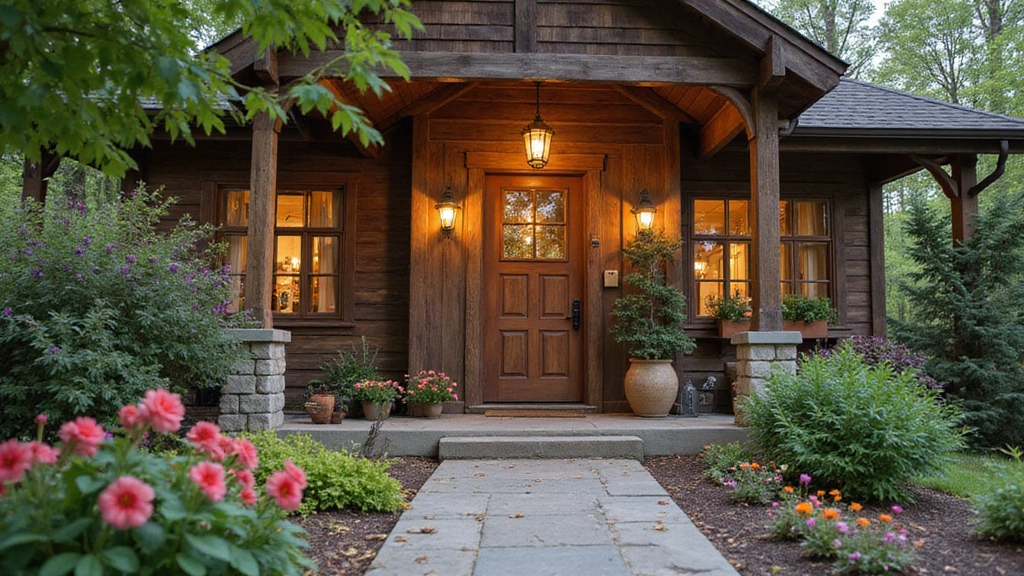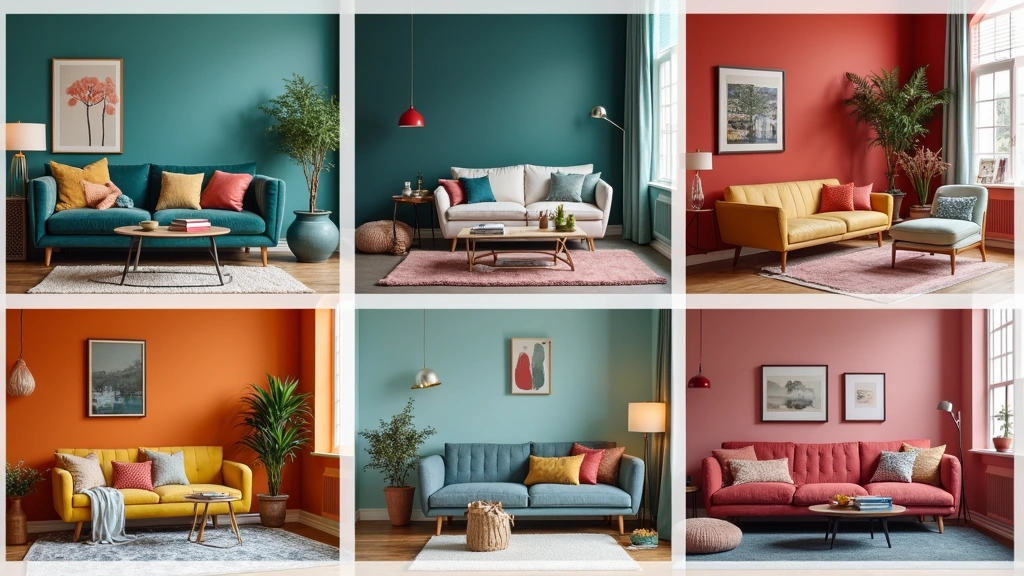Loud nights and thin walls have been stealing my creative focus. This post grew from my need to carve a calm, practical space for music. I wanted to show that you can make a real change with simple decor tweaks, not with a loud, expensive remodel.
If you are a musician, a songwriter, a podcaster, or anyone who uses a home studio, this one’s for you. You care about good sound, a space that feels like you, and gear you can actually put in place this weekend.
Here you’ll discover thirteen soundproof room decor hacks that are practical, affordable, and easy to test. They focus on reducing echoes, softening hard surfaces, and creating a sanctuary you want to spend time in. You’ll get ideas you can mix and match, from rugs and curtains to smart furniture layouts and door gaps.
Soft textiles like a thick rug and heavy curtains soak up sound. A wall with fabric hangings or a quilted panel can calm reflections. A sturdy bookcase filled with books and records acts as a gentle diffuser. Door sweeps and weather stripping keep stray sound from sneaking in. A few portable acoustic panels placed behind drums or amps can tune the space without looking like a studio. If your corner binds with low bass, consider a simple bass trap to tame it.
These tweaks won’t make a professional studio out of a shared room. They’ll help you cut echo, keep late-night neighbors happy, and make practicing feel calmer. Start with small changes, test what you hear, and adjust. Keep in mind placement matters; you want soft surfaces where sound bounces most.
Picture stepping into a room with a warm rug, a heavy curtain, and a bookshelf that muffles the drum hits. The air feels calmer, and your guitar notes ring clearer. With these touches, your music space becomes a sanctuary where you can focus, write, and record.
Ready to transform your space? Read on to explore the thirteen hacks and start turning your music room into a sanctuary.
1. Acoustic Panels: The Stylish Solution
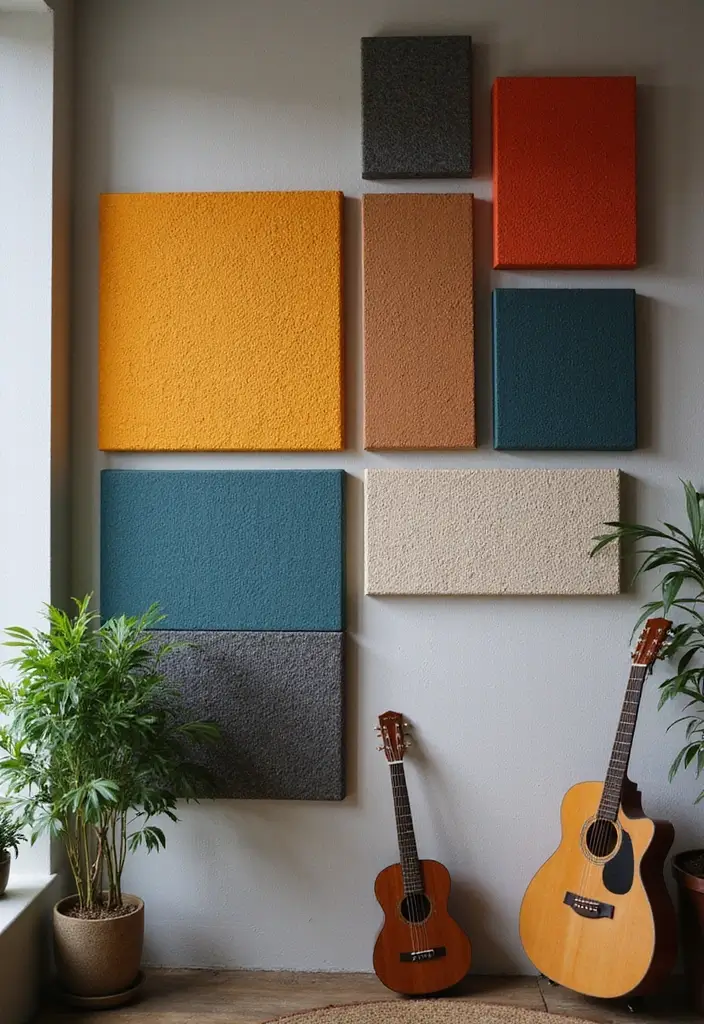
Your music room should feel calm and inviting. Acoustic panels do both. They absorb sound and add style, turning echoes into clean notes.
– Color to set the mood: Pick panels that fit your color palette. Light shades open the room, dark tones feel warm and intimate.
– Shape and pattern: Choose geometric cuts, soft curves, or fabric prints. You can feature band logos or album art for a personal touch.
– Mix and match: Combine different panel styles. A few fabric-wrapped frames with foam tiles create a lively, eclectic look.
– Smart placement: Start with the first reflection points—walls opposite your speakers and the ceiling above them. Add panels where you notice flutter echoes.
– Beyond walls: Mount panels on ceilings or use them as room dividers. They quiet the room and add practical design elements.
– DIY and materials: Options range from ready-made fabric panels to DIY fabric-wrapped frames. Choose thickness around 1–2 inches for everyday rooms.
This approach keeps a room feeling open while cutting unwanted noise. Start small, test a few panels, then add more as you hear the improvement.
Tip: choose panels with removable covers for easy cleaning.
Try a small setup first. Listen and adjust. See how it changes your room.
1. Acoustic Panels: The Stylish Solution
Editor’s Choice

52 Pack Acoustic Panels 1 X 12 X 12 Inches – Acoustic Foam – High Densit…
 Amazon$29.95
Amazon$29.95
BUBOS 4 PCS Acoustic Panels,23.6”x11.8”Fabric Soundproof Wall Panels,S…
 Amazon$96.99
Amazon$96.99
52 Pack Acoustic Panels 1 X 12 X 12 Inches – Acoustic Foam – High Densit…
 Amazon$29.95
Amazon$29.952. Rugs for Sound Absorption and Style

Choose the right rug
– Pick thick, plush rugs. They soak up sound better than thin mats.
– Go for textures and patterns that fit your style. A bold look adds character to practice time.
– Make it big enough for the space. A rug that covers the main floor of your practice area does the most good.
Layering for depth
– If you already have carpet, add a smaller decorative rug on top. Layering boosts sound control without crowding the room.
– On bare floors, use two rugs of different textures. The top rug adds style while the bottom layer improves absorption.
Placement hints
– Put rugs under seating areas to define the spot and soften steps.
– Place a rug near your instrument setup to tame reflections and keep amps from bouncing sound around.
– Use rug clusters to create listening corners and practice nooks with crisp, clear sound.
Care and setup tips
– Add a non-slip rug pad to keep it in place and dampen movement.
– Vacuum regularly and rotate rugs to wear evenly.
A thick, plush rug isn’t just for style; it’s your secret weapon against echoes! Transform your music room into a serene sanctuary where every note resonates beautifully.
2. Rugs for Sound Absorption and Style
Editor’s Choice

Ophanie Upgrade 6×9 Rugs for Living Room,Grey Fluffy Carpet Large Fuzzy …
 Amazon$34.99
Amazon$34.99
Veken Rug Gripper Pad for Hardwood Floors, Thick Cushion Non Slip Rug Pa…
 Amazon$7.59
Amazon$7.59
Superior Indoor Area Rug, Jute Backed, Modern Geometric Patchwork Floor …
 Amazon$22.00
Amazon$22.003. Heavy Curtains for Ultimate Sound Blocking
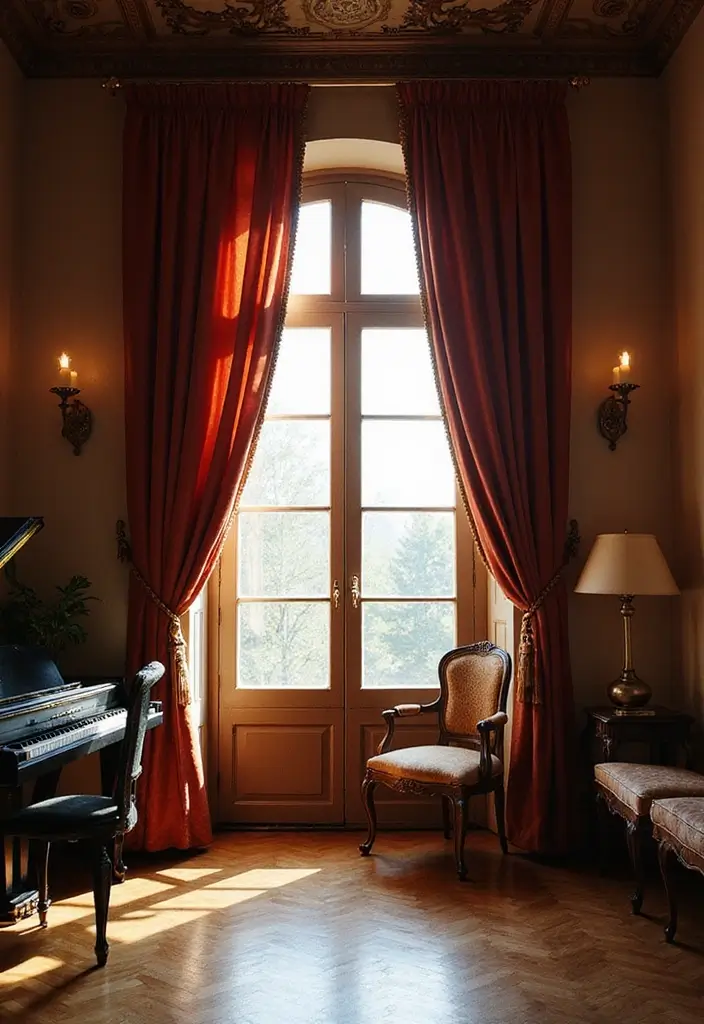
Noise from outside can ruin your practice time. You want focus and calm in your music room. Heavy curtains give you a simple, stylish fix. They add mass that absorbs sound and quiet echoes, yet they still look great.
– Thick, weighted fabrics: Choose thick, weighted fabrics like velvet or blackout lining. They add mass and absorb noise, especially street chatter. That extra mass also improves your room’s acoustic feel.
– Layer with a sheer: Hang a light sheer behind the heavy curtain on a second rod. The heavy layer blocks most noise; the sheer gentle light. Keep the sheer light and airy.
– Hang high and wide: Mount the rod high above the window and extend it past the edges. Let the curtain skim the floor to trap more sound. That helps the curtain pull more air and absorb noise.
– Use curtains as room dividers: If you share the space, pull a curtain to split your practice area. Ceiling tracks keep it steady. It also creates a flexible space for practicing.
– Care and tweaks: Keep fabrics clean so they stay thick. Check edges for gaps and add a second panel if needed. Wash as needed, and replace worn panels.
Heavy curtains help, but they are not a full soundproofing fix. Use them with other tricks for the best quiet and vibe.
3. Heavy Curtains for Ultimate Sound Blocking
Editor’s Choice

NICETOWN Black Velvet Blackout Curtains 96 inch Long for Bedroom and Liv…
 Amazon$29.99
Amazon$29.99
ChadMade Aluminum Ceiling Curtain Track Set with Hooks, 9ft – 12ft Adjus…
 Amazon$76.99
Amazon$76.994. Furniture Layout for Noise Management
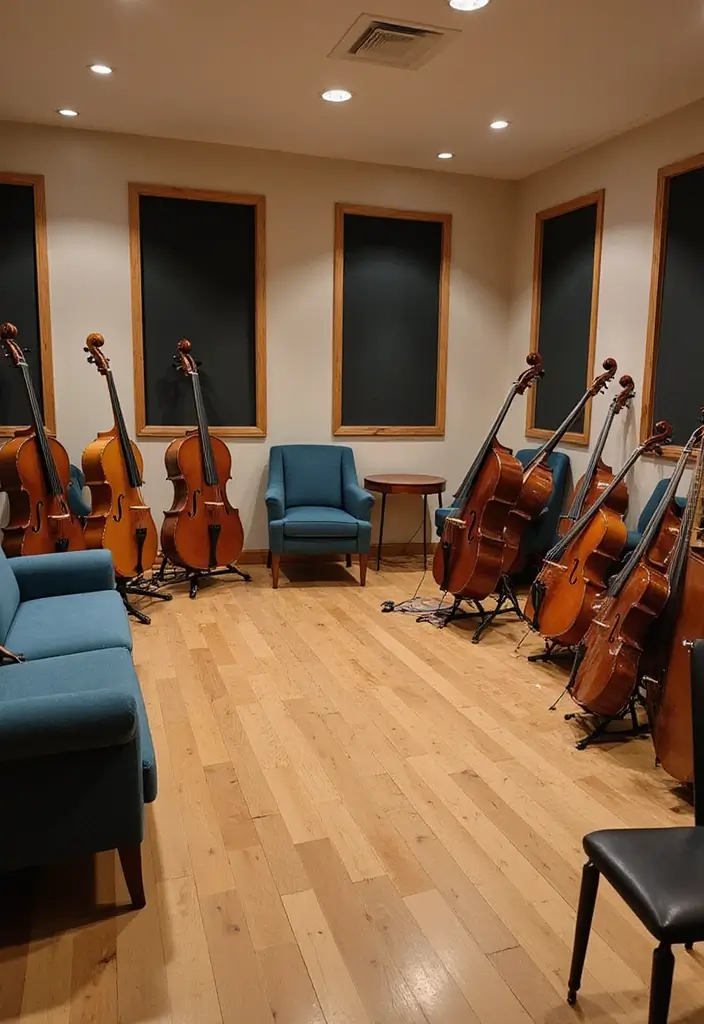
Struggling with echo in your music room? You can fix it with smart furniture placement. Think about where you sit, play, and listen. Small changes add up to clearer sound.
– Central instrument hub: Put your main gear in a tight cluster near the room’s center. Keep drums, amps, and keyboards together. Sound travels between them and spreads more evenly. This lowers harsh reflections from the walls.
– Keep hard surfaces away from walls: Move big pieces like shelves, desks, and cabinets a few feet from walls. That reduces sound bouncing back at you. Leave empty space on the wall side to soften launches and echoes.
– Add soft furnishings: A thick rug under the drums or piano soaks up vibration. A sofa or plush chairs catch stray echoes and warm the room’s vibe. Soft fabrics make the space feel calmer and easier to play in.
– Use curtains and diffusers: Hang heavy curtains over windows to absorb highs and lows. Place a bookcase with varied items on a wall to diffuse sound rather than reflect it. These touches keep the room lively without being loud.
– Test and adjust: Clap in the center and listen. If you hear flutter echoes, tweak chair positions or add a wall hanging. Keep trying until the space sounds balanced.
4. Furniture Layout for Noise Management
Editor’s Choice

52 Pack Acoustic Panels 1 X 12 X 12 Inches – Acoustic Foam – High Densit…
 Amazon$29.95
Amazon$29.95
SAFAVIEH Area Rug 8×10 – Arizona Shag Collection – Large – Ivory & Beige…
 Amazon$211.99
Amazon$211.99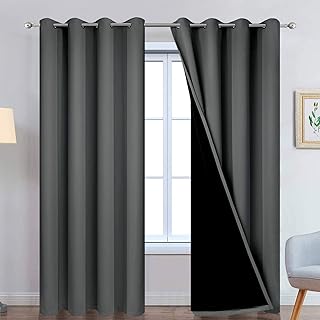
Yakamok Dark Grey Full Shade Curtain Panels, Heavy Duty Lined Curtains 8…
 Amazon$44.99
Amazon$44.995. Soundproofing Foam: A Budget-Friendly Option
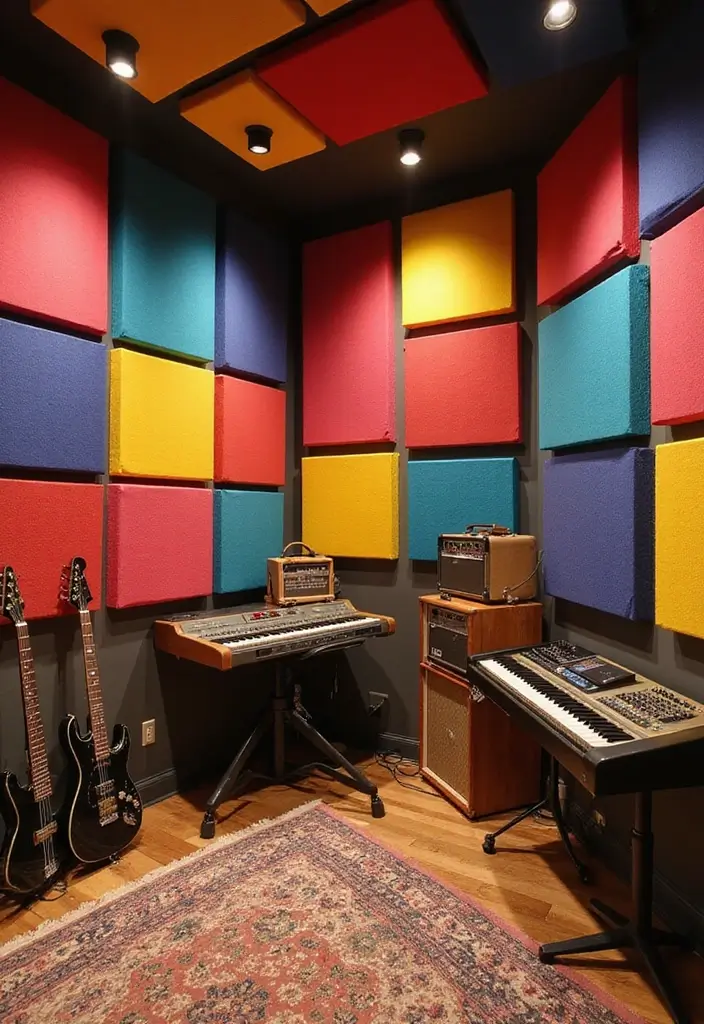
If you want to quiet a music room without breaking the bank, soundproofing foam panels are a solid option today. These lightweight tiles soak up echo and harsh reflections, making your music sound cleaner. You can cut them to fit any wall and stick them on with adhesive backing. They work best on mid and high frequencies; they won’t fix heavy bass alone.
Placement ideas
– Install foam in corners to slow down bouncing walls.
– Create a decorative pattern by mixing colors that match your room.
– Keep installation simple with adhesive backing; press firmly for 20–30 seconds.
– Try vertical strips along doorways or windows to catch early reflections.
Pro tips
– Place panels at the first reflection points near your listening chair.
– Add a few panels behind your monitors or speakers to reduce muddiness.
– For larger rooms, cover more wall area or pair foam with other treatments later.
– Rotate panels every few months to keep them effective.
Bottom line
– Foam panels give you a cheap, quick win that makes a real difference.
– They’re not a cure-all, but they are a smart starting point for better sound.
5. Soundproofing Foam: A Budget-Friendly Option
Editor’s Choice

52 Pack Acoustic Foam Panels 1″ x 12″ x 12″ Sound Proof Foam Panles Soun…
 Amazon$36.99
Amazon$36.99
3M Super 77 Multi-Surface Spray Adhesive, 7.35 oz., Low VOC, Quick Bond,…
 Amazon$9.99
Amazon$9.996. Artwork with Acoustic Properties

You want a music room that looks good and sounds calm. Artwork with acoustic properties helps you get both. It adds color and texture while softening echoes. This lets you decorate and treat the room at once.
– Soft textiles as sound sponge Fabrics soak up sound better than bare walls. Look for tapestries or canvas art with fabric surfaces. Hang pieces where sound bounces, such as near seating or behind speakers. The soft textures cut echoes and add warmth.
– Gallery walls that blend art with panels Mix traditional art with thin acoustic panels in matching frames. This reads as art and acts as treatment. Place panels between frames or along the lower wall to catch reflections from speakers. It keeps the room lively without harsh echoes.
– Custom pieces that double as acoustic tools Work with local artists to design art that includes soft materials. They can add felt, cork, or layered fabrics inside frames. Size and color match your decor while adding quiet power. You get a one-of-a-kind piece that helps sound stay clear.
Start small. Swap one fabric piece and test the sound. If you like the result, add another panel and a custom art piece later.
Transform your music room into a sanctuary! With artwork that has acoustic properties, you can beautify your space while keeping the sound just right. It’s all about harmony for the eyes and ears!
6. Artwork with Acoustic Properties
Editor’s Choice

Acoustical Wall Panels, 6-Piece 23.62 X 23.62 Inches Art Acoustic Panels…
 Amazon$110.49
Amazon$110.49
Llamazing Forest Tapestry Home Decor Landscape Tapestry Living Room Bedr…
 Amazon$9.99
Amazon$9.99
Customized Soundproof Panels, Personalized Acoustic Sound Absorbing Wall…
 Amazon$37.99
Amazon$37.99You might also like
7. Plants: Nature’s Sound Absorbers
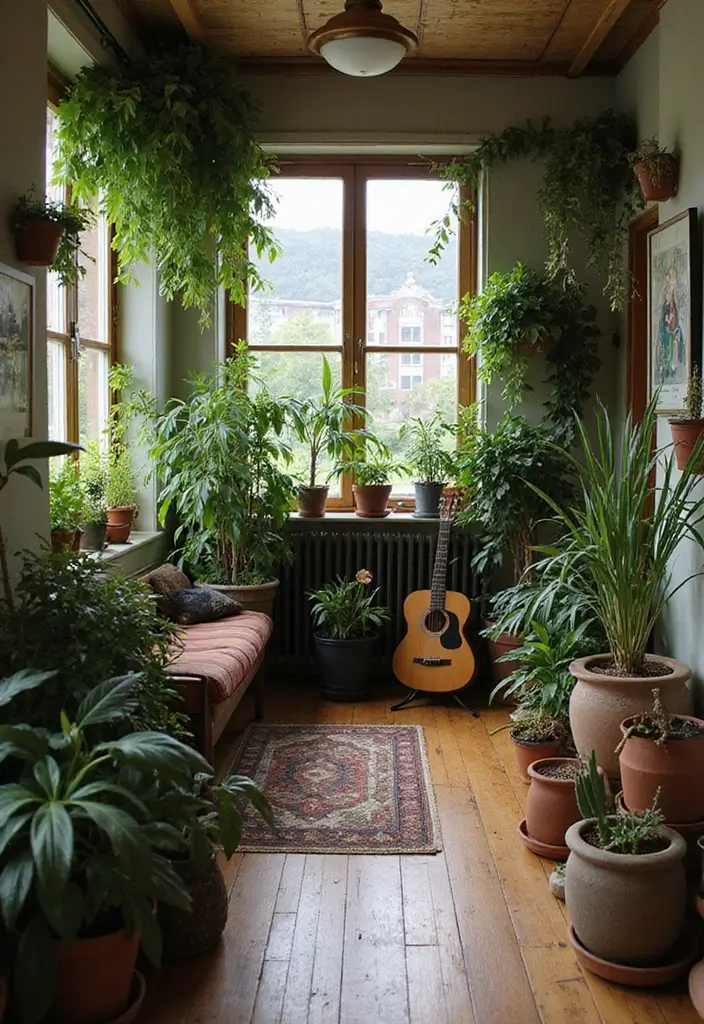
Soundproofing a music room isn’t only about panels. You want a calm space where you can play without too much echo. Plants can help with that. They bring life and gently quiet the room.
– Pick big, leafy plants. Large leaves break up sound waves better than small ones. Try Ficus or Rubber plants. They work well on mid and high frequencies.
– Add stands to create height. Elevating plants adds layers in your decor. Stands make a visual wall of greenery that also soaks up sound.
– Group plants to form a natural barrier. Clusters of leaves and stems act like a soft shield. You’ll notice a quieter feel in the space.
– Place greens near hard surfaces. Put plants near glass, tile, or drywall where echoes bounce. Position a few by your listening spot to cut glare and flutter.
– Care keeps the sound benefits strong. Water regularly, wipe dust, and rotate pots. Healthy leaves soak up more sound and look vibrant.
Remember, plants help, but they aren’t a full fix. Use them with proper acoustic treatment for the best results. Greenery adds mood, improves air, and makes your music room feel like a sanctuary.
7. Plants: Nature’s Sound Absorbers
Editor’s Choice

6FT Artificial Ficus Tree with White Planter, Realistic Faux Silk Indoor…
 Amazon$59.99
Amazon$59.99
Burgundy Rubber Plant, 8 inch Pot, Live Indoor Ficus Elastica Tree, 2-3 …
 Amazon$28.99
Amazon$28.99
Airpark Plant Stand Indoor Adjustable, Metal Modern Plant Stands, Heavy …
 Amazon$9.99
Amazon$9.998. Bookcases for Acoustic Balance
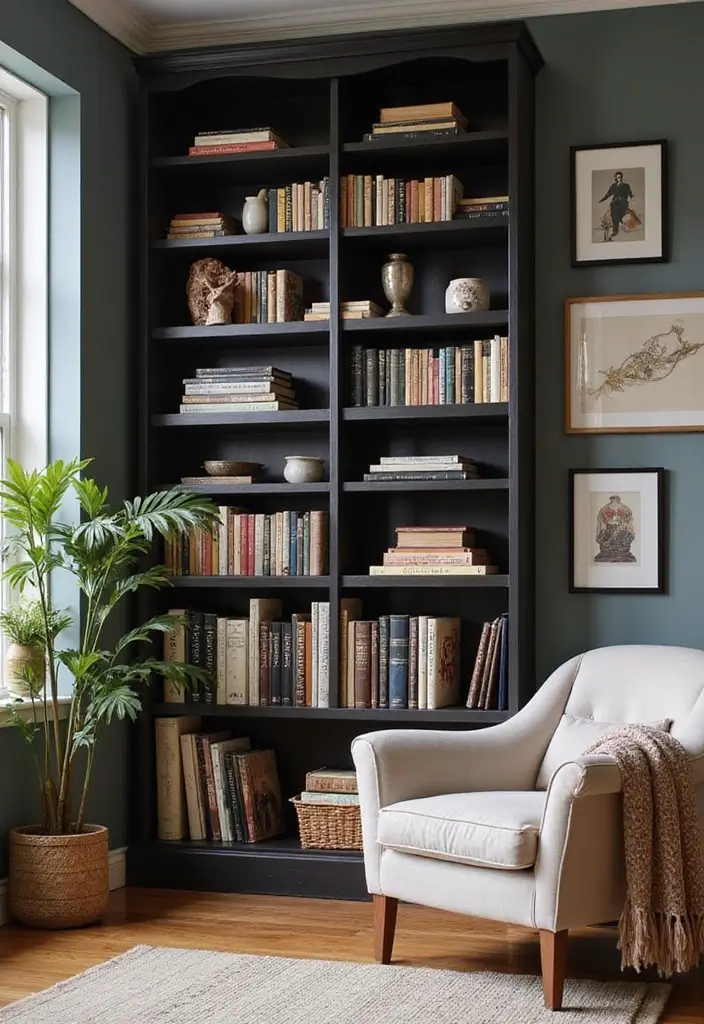
You want a quieter music room without losing style. A bookcase can help. It works as a light sound barrier when you fill it with books. Best of all, it’s budget-friendly and easy to adjust later.
– Fill with books Stack heavy volumes first; dense stacks soak up more sound. Mix in different sizes to keep it practical. Avoid leaving shelves mostly empty; a few heavy books make a bigger difference. Add a few decorative items so it still looks like your space.
– Back panel treatment Paint the back of the bookcase with acoustic paint. This adds a second layer of damping and helps the shelf act like a small acoustic panel. It’s a simple upgrade that pays off. Follow the paint label and let it dry before loading items.
– Strategic placement Push the shelf against the wall that carries the most noise. Line up several shelves to form a larger barrier. Leave a little space for air and for you to access items while keeping the barrier strong. If you share the room, consider matching bookcases on both sides to double the effect.
Turn your bookcase into a soundproofing helper while showing off your favorite reads. Keep the shelves sturdy and check for gaps every few months.
8. Bookcases for Acoustic Balance
Editor’s Choice



Sauder Miscellaneous Storage 3 Bookcase/Book Shelf, L: 35.28″ x W: 13.23…
 Amazon$144.25
Amazon$144.259. DIY Soundproofing Solutions
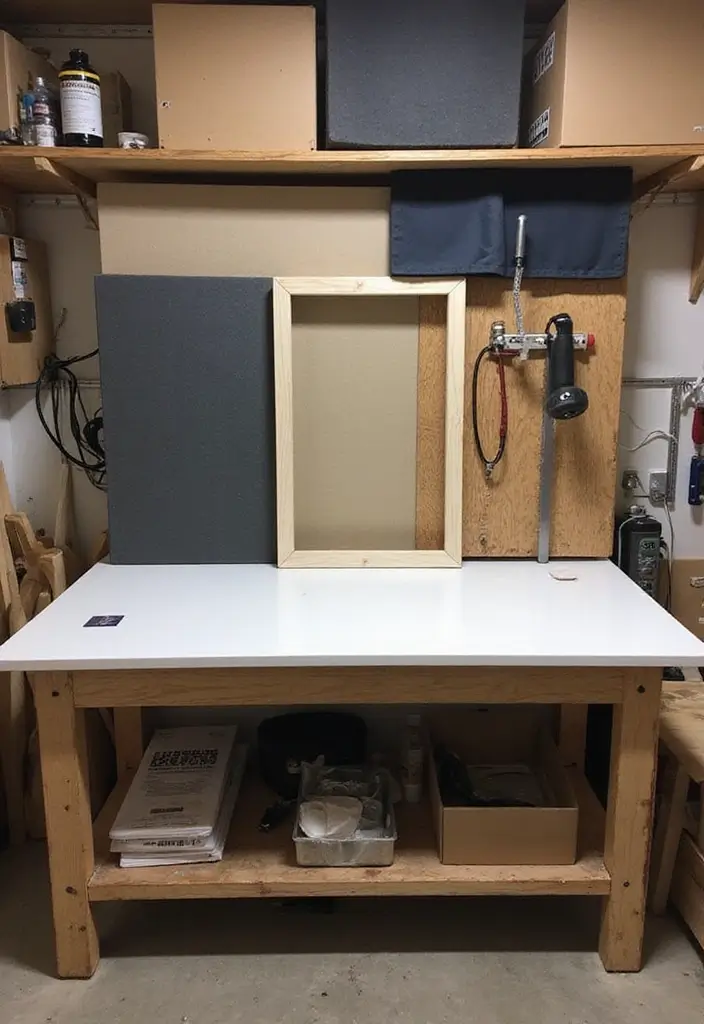
If you like a hands-on fix, DIY methods let you tune sound control exactly where you need it. These projects save money and teach you where noise leaks hide.
– DIY soundproof curtains — Choose heavy fabrics like canvas or denim and add a blackout liner. This mass helps cut noise and tame echoes. Hang them on a wide rod to cover the full window and seal edges. You can sew or glue layers for a budget-friendly finish. The result is a calmer window view and less street noise.
– Homemade acoustic panels — Build a simple wooden frame and fill with dense insulation such as rock wool or high-density foam. Cover the panel with a tight, breathable fabric. Mount on walls at first-reflection points and in corners for best effect. They soak up sound and sharpen your tone.
– Door sweeps and seals — Fit a door sweep at the bottom to block sound leaks. Pick a brush or rubber sweep that fits the gap. Cut to length and install with screws or adhesive. Add weatherstripping around the frame for extra seal.
Start small, measure the difference, and build from there. You’ll end with a quieter space you can actually enjoy. Try one idea first.
9. DIY Soundproofing Solutions
Editor’s Choice

Barcelonetta | Canvas Fabric | Cotton Duck | Heavy | Natural 10oz | 62”…
 Amazon$13.90
Amazon$13.90
AK TRADING CO. Upholstery High Density 2″ Height x 24″ Width x 72″ Lengt…
 Amazon$26.50
Amazon$26.50
GroTheory 2 Pack Door Draft Stopper, Under Door Sweep for Exterior & Int…
 Amazon$9.99
Amazon$9.9910. Soundproofing Paint for Walls
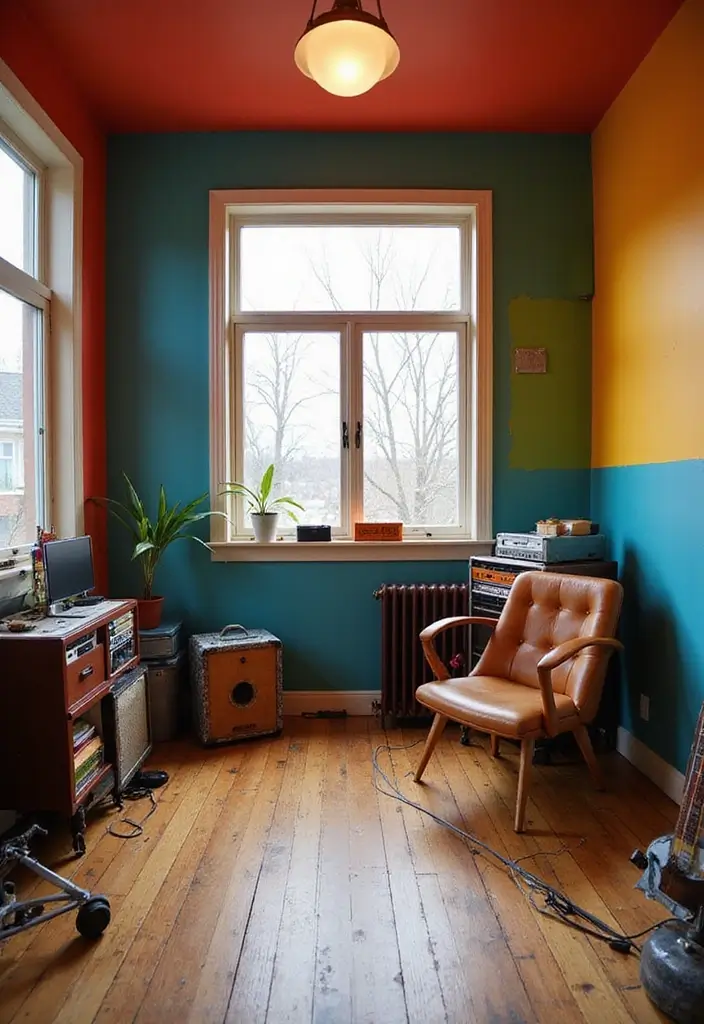
You want quieter sound in your room without adding bulky panels. Soundproofing paint offers a slim, simple boost. It sticks to walls and helps absorb some of the room’s noise. It won’t stop every sound, but it reduces echoes and keeps your practice clearer.
– What it does: The paint traps mid and high frequencies, turning a loud wall into a softer surface. It works best when used with other materials.
– Choose the right finish: You can pick from matte to satin. Choose a color that fits your style and won’t glare as you play.
– Easy to apply: Apply it like regular paint. Use a brush or roller, and you can refresh a wall in a weekend.
– Steps for best results:
1) First, clean the wall so dust won’t ruin the finish.
2) If needed, prime the surface before painting.
3) Apply two coats for stronger sound absorption.
4) Let each coat dry fully and air out the room between coats.
– Maximize the effect: Add soft furnishings—curtains, rugs, and a thick couch—to dampen sound further. Place bass traps in corners for extra control.
– Be honest about limits: It helps a lot, but it won’t replace acoustic panels in a serious studio.
– Maintenance: Wipe with a damp cloth and touch up scuffs as needed.
– Tips for success: Test a small patch first to hear how the room changes. Look for low-VOC or zero-VOC formulas for cleaner air.
Transform your walls into sound-absorbing allies! With soundproofing paint, you can reduce echoes and elevate your music practice without the bulk. Every layer counts in creating your perfect sanctuary!
10. Soundproofing Paint for Walls
Editor’s Choice


Extra Large Sound Dampening Blanket,96″x 80″ Sound Absorbing Studio Blan…
 Amazon$56.99
Amazon$56.99
8 Pack – Bass Traps Acoustic Foam Corner, 8”x8”x12” Black Bass Traps …
 Amazon$27.99
Amazon$27.99You Might Also Like
11. Incorporate a Practice Booth
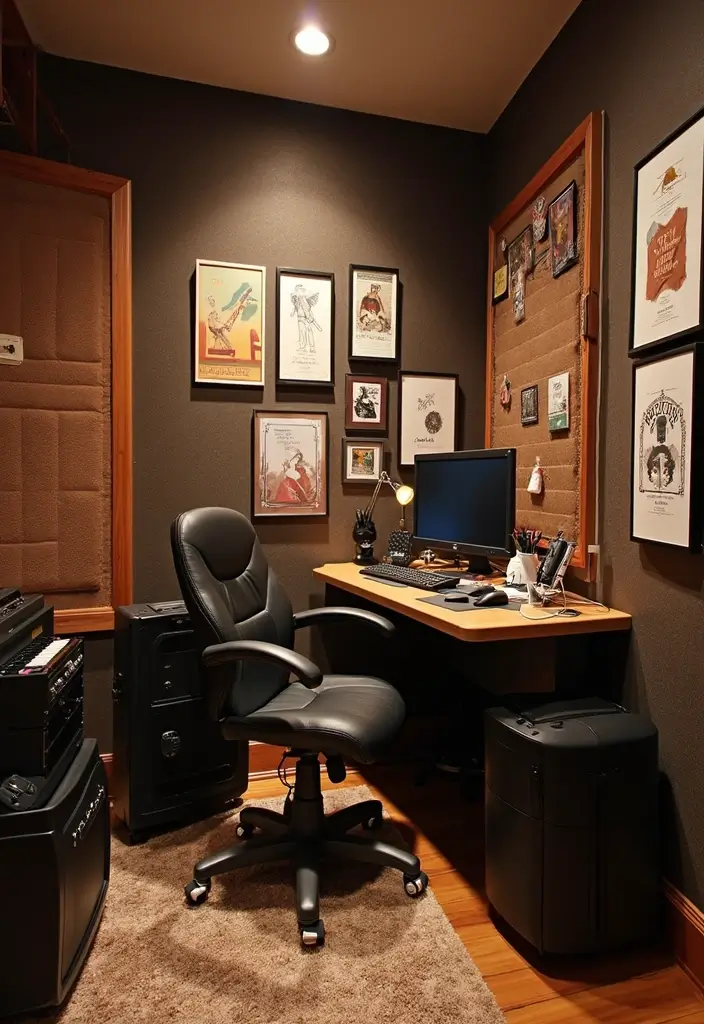
If your practice drifts into the living room or echoes off every wall, your focus can slip away. A dedicated practice booth gives you a quiet, controlled space where sound stays in and you stay in the groove.
– Build or buy a prefabricated booth: Choose a model with strong sound isolation, thick double walls, a tight door seal, and quiet ventilation so noise stays out and sound stays in.
– Personalize the interior: Add comfy seating, warm lighting, and small shelves so the space feels inviting and you can keep cables and tools organized during long sessions.
– Use it for recording: Treat the booth as a compact recording space where clean takes mean fewer edits and your tracks come together faster.
– Maximize acoustics with simple tweaks: Fit portable panels, a bass trap, and smart speaker placement to tame reflections without breaking the budget.
A practice booth isn’t just a box. It’s your personal sound sanctuary where practice becomes productive and creativity flows. With the right setup, your music room stays calm, and your best takes stay in your control.
11. Incorporate a Practice Booth
Editor’s Choice

‘Snap Studio’ Portable Recording Booth | ‘#1 Vocal Booth’ Rolling Stone …
 Amazon$499.99
Amazon$499.99
52 Pack Acoustic Foam Panels 1″ x 12″ x 12″ Sound Proof Foam Panles Soun…
 Amazon$36.99
Amazon$36.99
8 Pack – Bass Traps Acoustic Foam Corner, 8”x8”x12” Black Bass Traps …
 Amazon$27.99
Amazon$27.9912. Ceiling Treatments for Enhanced Acoustic Quality
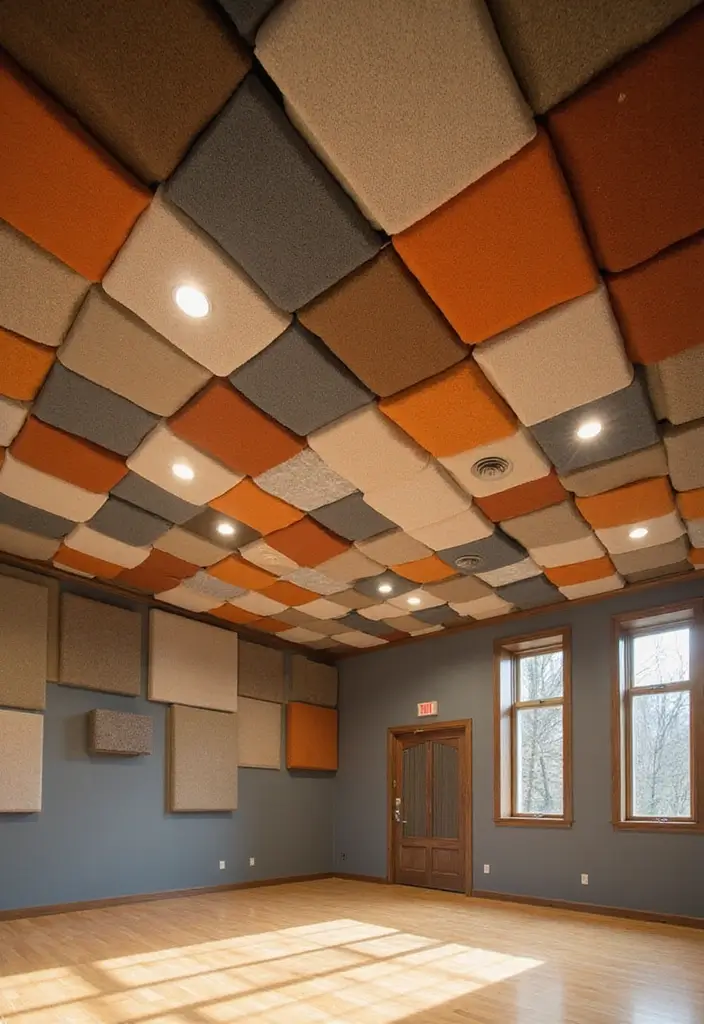
Your ceiling often gets ignored, but it can change how your music room sounds.
When sound bounces from above, it makes notes feel harsh or rooms feel louder than you want.
Ceiling treatments calm that problem by soaking up echoes and smoothing reflections.
Here are practical options you can use today.
– Acoustic tiles: They absorb sound, especially in rooms with high ceilings. Look for tiles with a clear NRC rating. Install them in a grid or on a drop-in frame to fit your space. They’re quick to add and easy to replace.
– Fabric panels: Soft fabric panels pull noise down and add texture. Hang them directly from the ceiling, or suspend them in rows for a factory-like, modern look. Choose colors that match your decor to keep the room calm, not busy.
– Decorative ceiling ideas: Make the ceiling part of the vibe while damping sound. Try wood slats, fabric baffles, or painted ceiling clouds. Matte finishes help reduce glare and bounce. Mixing materials creates warmth and better acoustics.
Take measurements, plan a layout, and start small. You can begin with a single wall-to-ceiling zone. Monitor the results and tweak as needed. Ceiling work can be a big improvement without breaking the bank. Test the room after each change, then adjust.
12. Ceiling Treatments for Enhanced Acoustic Qu…
Editor’s Choice
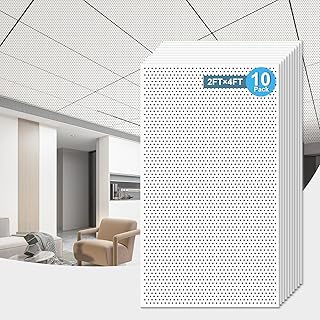
Art3d Acoustic Drop Ceiling Tiles 24×48 10-Pack, Soundproof Panels 2x4ft…
 Amazon$139.99
Amazon$139.99
SoundAssured Acoustical Fabric – Acoustically Transparent Fabric for Mak…
 Amazon$21.95
Amazon$21.95![[6-Pack] 6](https://m.media-amazon.com/images/I/716n2YARyKL._AC_UL320_.jpg)
[6-Pack] 6″ Metal Recessed Can Light Trim Cover, Step Baffle with Ring, …
 Amazon$32.99
Amazon$32.9913. Personal Touches with Soundproofing Benefits
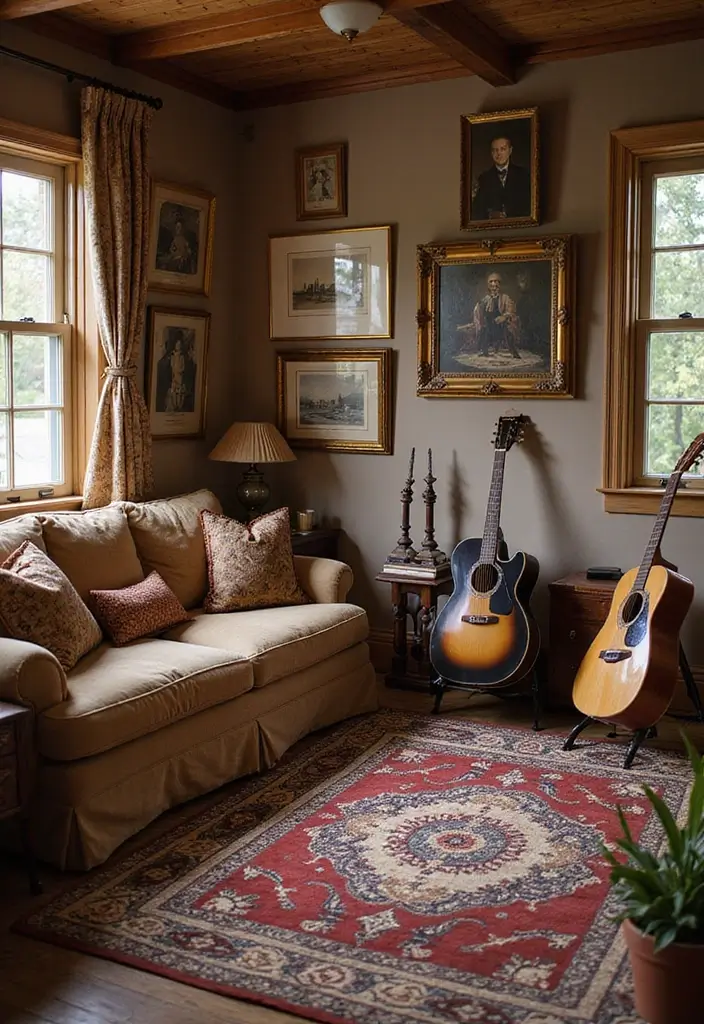
Your music room should feel like you, but also stay calm when you turn up the volume. You can mix style with sound control. Here are personal touches that help soundproof while they show your taste.
– Thick frames and heavy art: Framed pieces with sturdy frames absorb more sound. Hang a few in the listening zone to cut echoes.
– Decorative cushions and throws: Plush cushions and thick throws soak up sound. They slow reflections on walls and soften footsteps.
– Soft textiles everywhere: A rug under your chair, a wall tapestry, and fabric curtains soak up sound. Layer fabrics for better absorption.
– Art with a practical twist: Choose art that doubles as sound panels. Look for fabric-wrapped panels that blend with decor.
– Books and shelves: A wall of books and sturdy shelves slows sound waves. Fill gaps with soft items to boost absorption.
– Plants for life and sound: Leafy plants add texture and help soften room reflections. They’re cheap and simple.
– DIY acoustic art: Make DIY acoustic art with cork, felt, or foam behind a frame. It also dampens noise.
– Placement and rhythm: Don’t crowd corners. Place a large piece off-center to break standing waves and keep balance.
These touches keep your mood, your music, and your room in harmony.
Personalize your soundproof room decor! A touch of style can absorb sound and create a calming space. Make your music room a true sanctuary of creativity and comfort!
13. Personal Touches with Soundproofing Benefits
Editor’s Choice

52 Pack Acoustic Panels 1 X 12 X 12 Inches – Acoustic Foam – High Densit…
 Amazon$29.95
Amazon$29.95
Utopia Bedding Throw Pillows (Set of 4, White), 18 x 18 Inches Pillows f…
 Amazon$25.49
Amazon$25.49
8×10 Area Rugs for Living Room – Washable Rug Modern Abstract Soft Large…
 Amazon$58.99
Amazon$58.99Conclusion
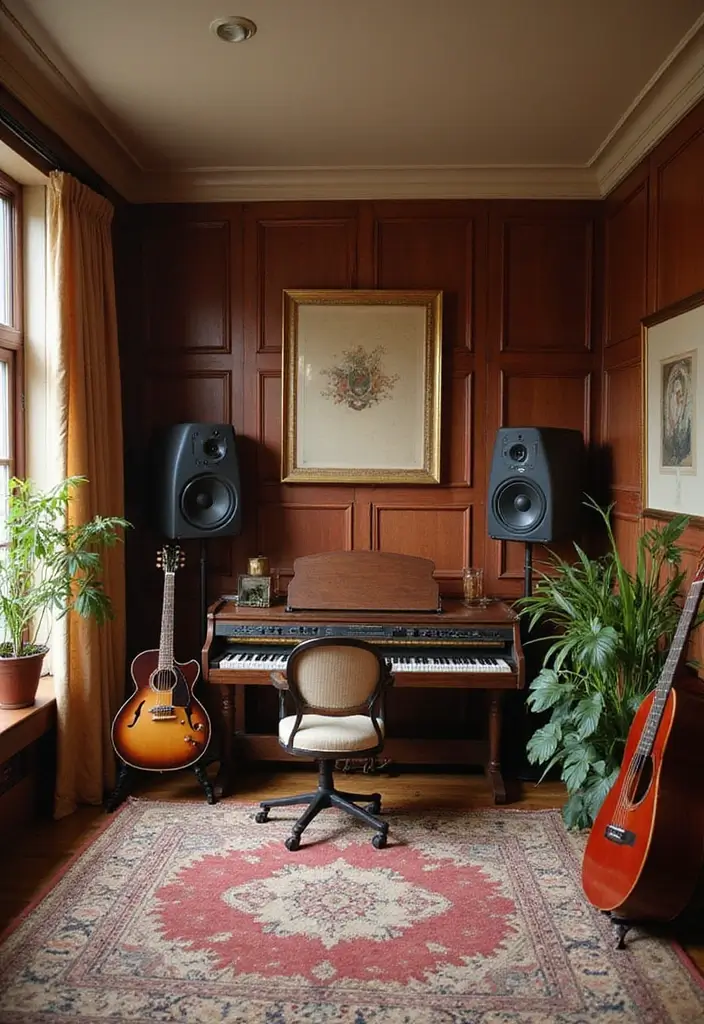
Creating the ultimate music sanctuary involves a thoughtful blend of soundproofing and personal style.
By incorporating these decor hacks, you can ensure your space not only sounds great but feels like home.
Whether you’re a seasoned musician or just starting out, these ideas will guide you in crafting a room that inspires creativity and harmony.
Note: We aim to provide accurate product links, but some may occasionally expire or become unavailable. If this happens, please search directly on Amazon for the product or a suitable alternative.
This post contains Amazon affiliate links, meaning I may earn a small commission if you purchase through my links, at no extra cost to you.
Frequently Asked Questions
What are acoustic panels, and how do they help in soundproof room decor?
Acoustic panels are specially designed materials that absorb sound waves, reducing echo and improving sound quality in your music room. They not only serve a practical purpose but also come in various designs and colors, allowing you to enhance your room’s aesthetic while achieving effective soundproofing. By incorporating acoustic panels into your decor, you can create a more inviting and calm atmosphere for your music practice.
Can rugs really make a difference in reducing noise in my music room?
Absolutely! Rugs are fantastic for sound absorption and can significantly cut down on echoes and noise. They help to soften footsteps and create a warmer ambiance in your music room. Choosing a thick, plush rug can enhance the overall sound quality, making your playing experience much more enjoyable. Plus, they add a stylish touch to your decor!
What types of curtains are best for soundproofing a music room?
For effective soundproofing, heavy curtains or blackout curtains are your best bet. These curtains add mass, which helps block outside noise and minimize echoes within the room. When selecting curtains, look for those made from thick, dense fabrics. Not only will they help maintain your focus during practice, but they also add an elegant flair to your music room decor.
How can I DIY soundproofing solutions for my music room on a budget?
DIY soundproofing can be both fun and cost-effective! You can create soundproof curtains using heavy fabric or blankets, and even make your own acoustic panels using foam or soft materials. Additionally, rearranging your furniture can help manage noise levels. Placing bookcases filled with books can act as sound barriers, while plants can absorb sound and beautify your space. The key is to get creative and tailor solutions to your specific needs!
What personal touches can I add to my music room while keeping it soundproof?
Mixing style with soundproofing is totally achievable! Incorporate artwork with acoustic properties to enhance both decor and sound quality. You can also use plants, which not only add a touch of nature but help absorb sound. Personal items like your favorite instruments or music memorabilia can reflect your taste while maintaining a calm atmosphere. This way, your music room becomes a true sanctuary that represents you!
Related Topics
soundproof room decor
acoustic panels
DIY soundproofing
noise reduction
music room design
budget friendly
home studio
sound absorption
interior acoustics
easy soundproofing
creative space
decor hacks
